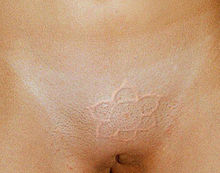Scarification

|

|
|
|
Traditional scarification in Ethiopia
|
Modern scarification
|
As scarification or scarification (from Latin scarificatio : "(das) Ritzen", "(the) cupping") or also called scar tattooing , the introduction of decorative scars into the skin is called.
history
Traditional scarification
Scarification is a form of body modification that is deeply anchored in the traditions of various peoples . It is particularly widespread among those ethnic groups whose dark skin does not allow a tattoo or makes it difficult to see. This is carried out in particular in the Nilo-Saharan language family of Sudan and Chad , but also in Nigeria , Kenya , Tanzania , Mozambique and Angola and serves on the one hand for clan allocation , on the other hand as a body ornament , but also for the initiation of girls at the border of marriageable age . In addition, other important life events, both of the person concerned and of loved ones, can be a reason for adding jewelry scars.
Among the ethnic groups in the Sepik area in Papua New Guinea , scarification is an important spiritual and mythical initiation ritual for men ( see: Scarification on the central sepik )
Modern forms of scarification

In various youth subcultures of the western world today, scars are cut as a body modification. This overlaps with the ritual scarification of the “ primitive peoples ” insofar as the delimitation from other groups is intended and this is viewed as a form of body jewelry. The motivation that exists in a psychological sense of enduring pain as an initiation into adult life may also play an important role, but it is neither rooted in a tradition nor a tribal cultural event involving the relatives.
A special style of scarification has developed with the Hanabira or Japanese flower. For women on the mound of venus, a flower pattern based on traditional forms is created. The style was invented in the Japanese bodmod scene in the early 1990s and has become increasingly popular in the western world, so far mainly in the USA, in recent years.
Methods
A distinction must be made between two methods when it is carried out: cutting and branding .
Cutting
The cutting is usually done with a scalpel , whereby the outlines or outlines are first cut and then the upper layer of skin in between is removed.
A study at the University of Liverpool has shown that men with facial scars are particularly attractive to women who are looking for short partnerships . This result was interpreted to suggest that scars evoke the association of masculinity (high testosterone levels ), courage and strength / health. The male participants in this study showed no preference (or disapproval) towards women with facial scars, either in potentially short relationships or in long-term partnerships.
Branding
In principle, any object heated to a certain temperature can be used for branding, but an electrocautery is used for professional use.
cure
In contrast to most other forms of body modification, slow and repeatedly disturbed wound healing is desirable in scarification. Depending on the desired scarring, the actors try to wet the fresh and healing cuts again and again with solutions of lemon, sugar and petroleum jelly or to remove the new skin cells and scabs.
Scarification for non-aesthetic reasons
Self-harming behavior as a psychological disorder differs from both forms in the sense that psychopathology is in the foreground and the aspect of body jewelry takes a back seat.
In addition, scarification is carried out for the virological diagnosis of smallpox disease on the cornea of the rabbit ; Furthermore, the smallpox vaccination itself is carried out using scarification on the upper arm.
In the western West, scarification by making small incisions in the skin formed the basis for the subsequent bloody cupping .
Scarification in the film
In 2019, Nigerian filmmaker and director Nadine Ibrahim created a short documentary film entitled Marked , which deals with the practices of scarification in Nigeria.
Individual evidence
- ↑ On the language of our skin - a brief cultural history of the skin
- ^ E. Kasten (2007): Genital Body Modifications in Women. The gynecologist, Volume 40, Number 6, 489–500 doi : 10.1007 / s00129-007-1985-8
- ↑ Ornamental scars (scarification) as body decoration
- ^ K. Miyake: Sexual behavior of the Japanese in the future.
- ↑ Rob Burriss et al. (University of Liverpool), Men With Facial Scars Are More Attractive To Women Seeking Short-term Relationships. Personality and Individual Differences, Nov. 19, 2008 (in English)
- ↑ Cutting and Skin Removal Diary with pictures from two weeks of healing
- ↑ Immerse yourself in the taboo art of scarification via short film Marked. October 24, 2019, accessed October 26, 2019 .
See also
Web links
- Medizin.at portal - focus on scars / scarification - medical and ethnological aspects
- German info page with many pictures about the process of cutting for scarification.
- ScarWars Art Project - portal of the international scarification scene
- Examples of Japanese Flower Scarification Picture1 , Picture2



